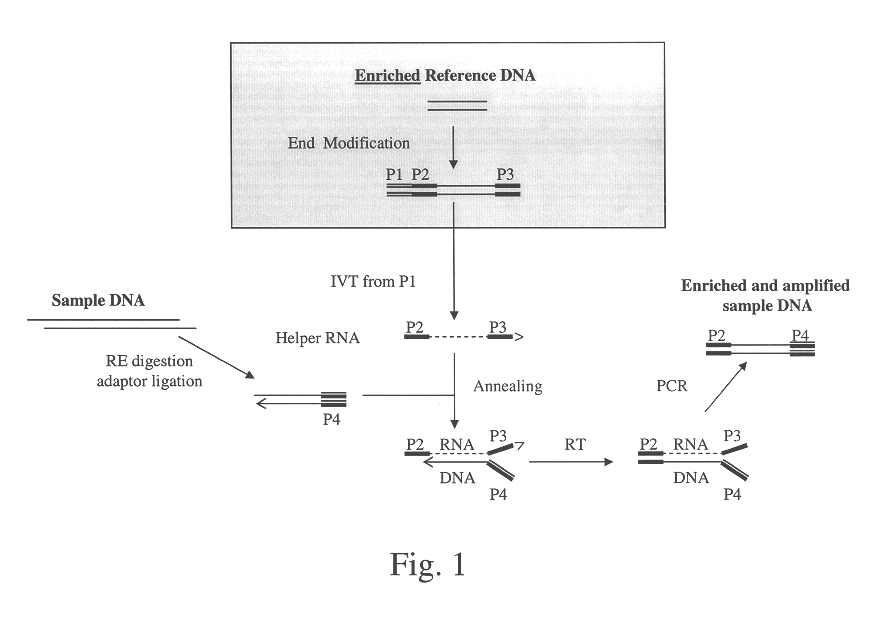Method of target enrichment and amplification
a target and dna technology, applied in the field of target enrichment and amplification, can solve the problems of complex and expensive methods of amplifying target dna sequences, and achieve the effect of accelerating the selective breeding process, difficult or costly monitoring during production
- Summary
- Abstract
- Description
- Claims
- Application Information
AI Technical Summary
Benefits of technology
Problems solved by technology
Method used
Image
Examples
example one
Amplifying known targets from a complex mixture using known PCR products to generate selection probes. (See FIG. 3A for a schematic and Table 1 for the sequences of the adaptors and primers used).
Step 1. Preparing sample DNA. Positive control DNA targets were mixed with background DNA to produce a complex sample mixture. To generate a first positive control, positive control 1, 88 different primers pairs were used to amplify 88 unique PCR products which were pooled in equimolar amounts. To generate a second positive control, positive control 2, 98 different primers pairs were used to amplify 98 unique PCR products which were pooled in equimolar amounts. The fragments were kinased and ligated to adapter, A3. Prior to ligation A3 was dephosphorylated to block ligation of the adaptor to the 3' end of each DNA.
The background DNA was isolated from human cell line K562 (Gibco BRL, Rockville, Md.) and digested with restriction enzymes MnlI and MseI (NEB, Beverly, Mass.) to an average size ...
example 2
Complexity reduction of genomic DNA using selection probes derived from a sub fraction of genomic DNA isolated from a gel. (See, FIG. 4)
Step 1: Sample DNA was genomic DNA digested to an average size of 100-200 base pairs using restriction enzymes BamHI, MnlI and MseI (NEB). After being blunt-ended by Klenow reaction, the DNA was ligated to un-phosphorylated adaptor A3 as in previous example (only the 5' phosphorylated genomic DNA fragment can be ligated at its 5' end with an adaptor strand, but not the 3' end).
Step 2: Preparation of selection probe RNA. Selection probes were prepared by digesting genomic DNA with BamHI, separating the fragments on a 0.8% agarose gel, cutting a band out of the gel corresponding to fragments of 1-1.2 kb and isolating the fragments from the gel slice. The isolated DNA was further digested to an average size of 100-200 base pairs using restriction enzymes MnlI and MseI. The fragments were blunted and adaptors, A1 and A2, were ligated to the fragments. R...
example 3
Complexity reduction by protection of targets by hybridized of selection probes. (See, FIG. 5).
Step 1. Fragment target genomic DNA
Digest 3 .mu.g human genomic DNA with restriction enzymes Aat II (NEB), which generates 3' protruding ends, and Sau3A I (NEB) which generates 3'-recessed ends, in 50 .mu.l 1.times.NEB buffer 4 at 37.degree. C. overnight. Inactivate the enzymes at 65.degree. C. for 20 minute.
Step 2. Generate single strand DNA by exonuclease digestion
Add to the above solution 1 unit exonuclease III (NEB) and incubate at 16.degree. C. for 10 minutes. Heat inactivate the exonuclease and denature the DNA by incubation at 99.degree. C. for 10 minutes. Cool on ice for 5 minute.
Step 3. Anneal synthetic selection probes to target DNA
Synthetic oligonucleotides are designed to be complementary to the strand that is not digested by the exonuclease. The oligonucleotides are mixed with the target genomic DNA in a 1000:1 ratio in NEB buffer4 (NEB) at 50.degree. C. on a rotisserie for ap...
PUM
| Property | Measurement | Unit |
|---|---|---|
| total volume | aaaaa | aaaaa |
| pH | aaaaa | aaaaa |
| pH | aaaaa | aaaaa |
Abstract
Description
Claims
Application Information
 Login to View More
Login to View More - R&D
- Intellectual Property
- Life Sciences
- Materials
- Tech Scout
- Unparalleled Data Quality
- Higher Quality Content
- 60% Fewer Hallucinations
Browse by: Latest US Patents, China's latest patents, Technical Efficacy Thesaurus, Application Domain, Technology Topic, Popular Technical Reports.
© 2025 PatSnap. All rights reserved.Legal|Privacy policy|Modern Slavery Act Transparency Statement|Sitemap|About US| Contact US: help@patsnap.com



